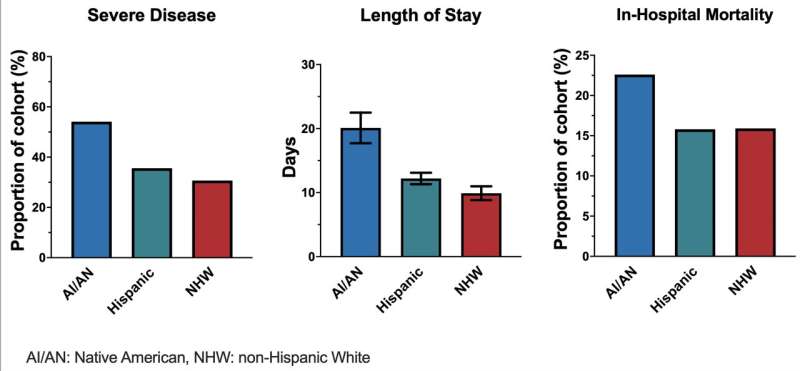Home » Health News »
Study finds disproportionate impact of COVID-19 on American Indians

A study of COVID-19 patients at a New Mexico hospital finds that the virus hit American Indian patients particularly hard—even though Native American patients had fewer other illnesses or conditions than non-native patients. Douglas Perkins and colleagues analyzed data on 475 patients with COVID-19 infections from the University of New Mexico Hospital. The sample was 30.7% Native American, 47% Hispanic, and 18.5% non-Hispanic White. The research is published in the journal PNAS Nexus.
At admission, Native American patients were younger, more likely to need mechanical ventilation, and had laboratory values indicative of more severe disease than other patients in the cohort. Being Native American was the highest risk factor for developing severe COVID-19. About 54% of the Native American patients developed severe disease, compared to about 36% of the Hispanic patients, and about 31% of the non-Hispanic White patients—despite COPD, sleep apnea, hyperlipidemia, hypothyroidism, and history of past smoking all being the lowest among Native American patients.
Additionally, the Native American population had the highest level of vaccination among ethnic groups in New Mexico during the study period, suggesting that vaccination status did not drive the disparity.
The researchers note that a similar pattern of relatively severe disease in Native Americans was seen during the 1918 influenza pandemic, historical tuberculosis outbreaks, and the 2009 H1N1 influenza pandemic. The actual causes of this notable discrepancy are likely multifactorial and may include social determinants of health, as well as potential immunological responses to the virus, among other factors, according to the authors.
More information:
Ivy Hurwitz et al, Disproportionate impact of COVID-19 severity and mortality on hospitalized American Indian/Alaska Native patients, PNAS Nexus (2023). DOI: 10.1093/pnasnexus/pgad259
Journal information:
PNAS Nexus
Source: Read Full Article



